At Gen Con this year, there were arguably three or four games with a tremendous amount of buzz around them. Of those, only one seems to have not only lived up to the hype, but it also blew away everyone’s expectations: Days of Wonder’s latest release, Five Tribes. Much of the buzz related to Five Tribes was due to the fact that the game was supposed to be meatier than Days of Wonder’s standard fare, more of a gamer’s game. So why was Five Tribes so talked about? Let’s find out.
Summary
The game takes place in the sand and oases of the Arabian land of 1001 nights. You are a traveler in the fabled Sultanate of Nagala where the old sultan has just died and control of the land is up for grabs. Your job is to fulfill an age-old prophecy by maneuvering the five tribes to gain influence over the city. If you can manipulate the tribes, invoke the old Djinns, and earn the most victory points, the Sultanate will be yours!
Five Tribes is a “worker displacement” area control game for two to four players, ages 13 and up. Gameplay is listed as taking between 40 and 80 minutes, but most of our games have been around 50 minutes.
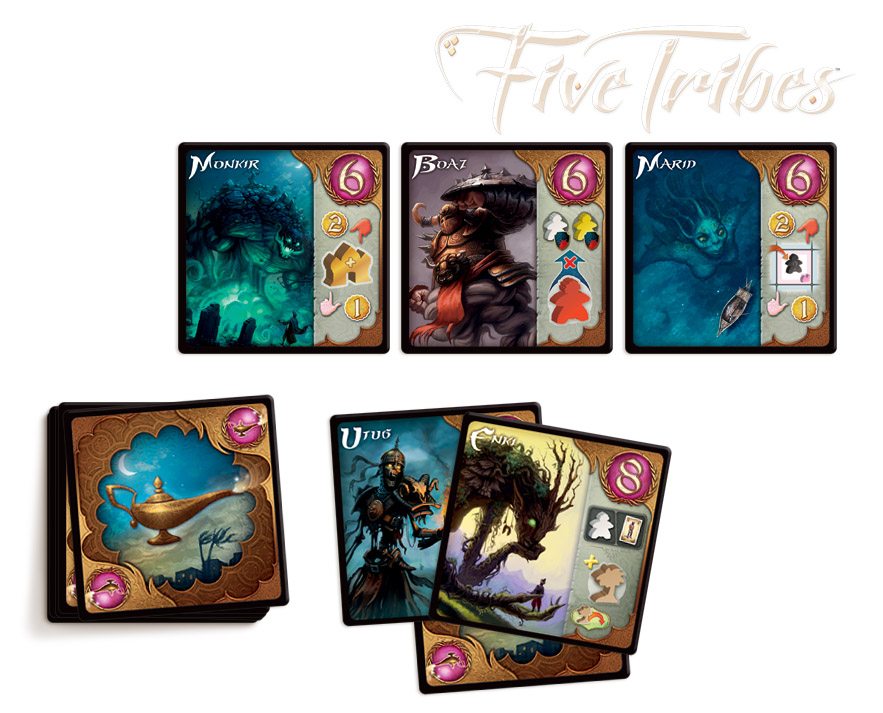
Components
I feel like a bit of a broken record saying this once again, but it’s Days of Wonder — the components are almost guaranteed to be of the highest quality with great artwork, and near perfect packaging. Guess what? Five Tribes checks all of those boxes. It’s beautifully and wonderfully constructed.
The box seems to have some extra storage, possibly for an expansion, but everything fits nicely and snugly and, as with all Days of Wonder games, save the cardboard frames after punching out the components and place them beneath the plastic box insert. This keeps everything flush with the lid and prevents all the pieces going everywhere during storage or transport.
How to Play
There are thirty tiles that make up the Sultanate. These represent villages, markets, sacred places, and oases. The sacred places and villages have blue values and the oases and small and large markets have red values that represent victory points at the end of the game. These are randomly arranged in a 6 x 5 grid and then three meeples representing the various tribes are randomly placed on each tile. A number of resource cards and Djinns are turned face up and players are given 50 gold coins to begin the game, along with colored camel tokens and a player token.
The first part of the game is a bid process to see who goes first, Player tokens are randomly placed on a bid order track (randomly for the first turn only, after that they are placed in order of turn order from the previous turn). Players take turns then moving their markers to the turn order track where they can pay increasing sums for the right to go first. There is also an option to bid nothing, but there are only three spots. So, in a four player game, at least one player will be forced to pay. Players beware! The gold coins you are bidding with are also counted as victory points at the end of the game, so bid wisely.
Once order is set, play begins in earnest. There are a series of tasks and they must all be completed before another player has the opportunity to take a turn. First, you move your player token from the turn order to the bid order for the next round. The player who went first this turn gets to bid first next turn.
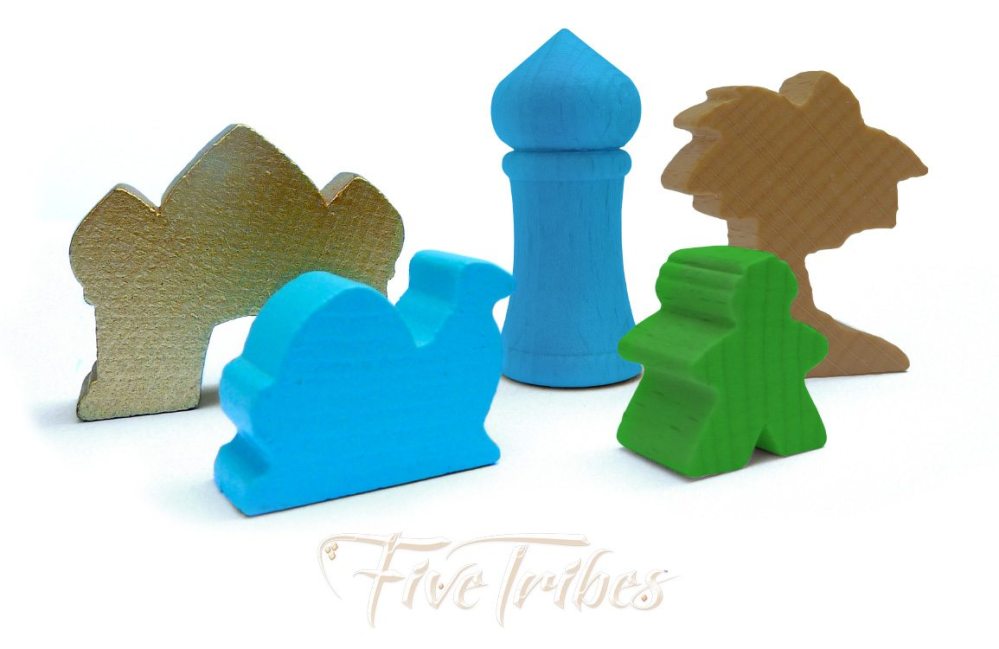
Next, you move the meeples. From a tile that has at least one meeple on it, you pick up these meeple(s) and hold them in your hand. The meeples must then be distributed, one at a time, on neighboring tiles by following three rules. First, tiles must be adjacent, you can’t jump to a tile that is diagonal and you only put a single meeple on a tile before moving to a tile that is adjacent to the tile where you just dropped a meeple. Second, you cannot immediately backtrack to a tile you were just on. Third, when you drop your last meeple on a tile, there must be a meeple of the same color there already.
When you drop your final meeple, you immediately pick it back up, along with all the other meeples on the final tile that are the same color. If, after picking up the meeples, the tile has now become vacant, you gain control of that tile. Place a camel of your color in the lower right hand corner of the tile and the victory points on that tile will be yours at the end of the game.
The next step in the turn are the tribe actions. Meeples come in five colors, representing the five tribes. Yellow meeples are the Viziers tribe and, when collected, are set in front of a player. At the end of the game, each Vizier will be worth a single gold coin and the player with the most Viziers gets an additional 10 victory points for each opponent that has fewer Viziers. The Elders are represented by the white meeples and are also placed in front of a player after collecting them. Elders are worth 2 victory points each at the end of the game, but can also be used to purchase and activate Djinns during the game. (More on that in a bit.)
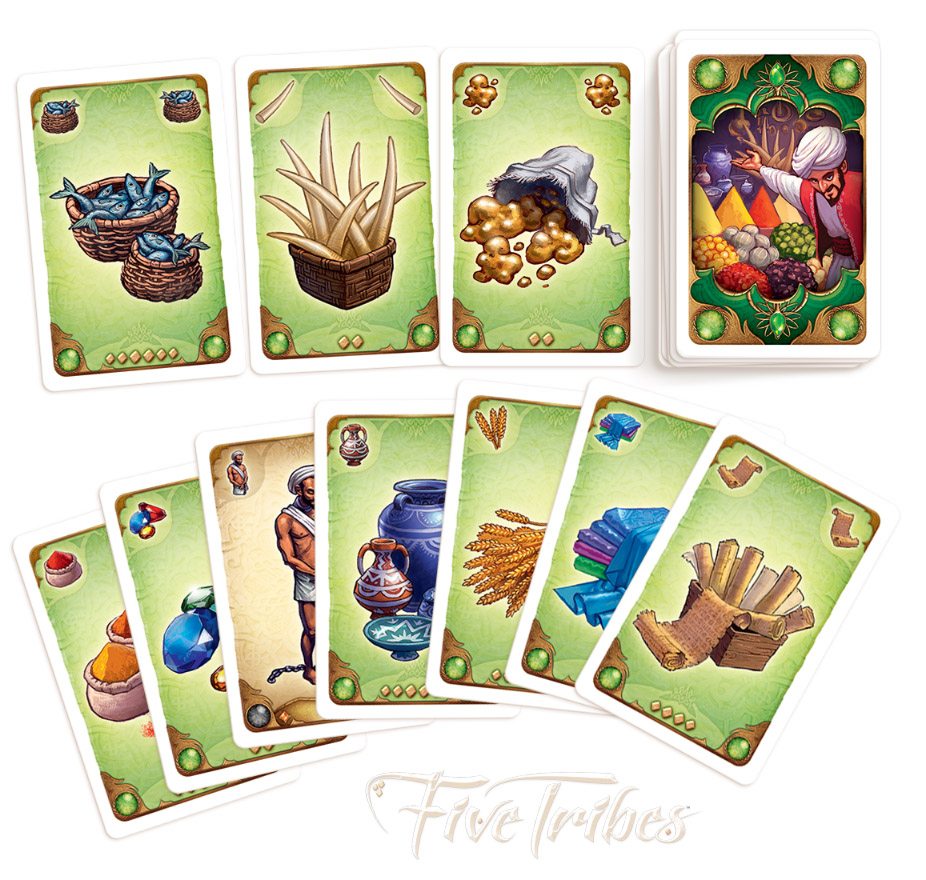
One of the best ways to get resource cards is with the green Merchant meeples. After collecting these guys, they go into the meeple draw bag, but you get one resource card from the market for each Merchant you collected. Resource cards can be used to score victory points at the end, returned to the bank for cash, or used to power other cards in the game. Blue meeples are the Builder’s Tribe and for this group, some math is involved. Begin with the number of blue meeples you just picked up this is multiplied by the number of tiles with blue values. You can modify your meeples multiplier by adding any slave resource cards you have.
Lastly, there are red Assassins Tribe meeples. When collecting these meeples, they are counted then placed in the meeple draw bag. Assassins allow you to eliminate a single meeple from the game, either by counting a number of adjacent tiles away from your final tile equal to the number of red meeples you collected and taking out a meeple on one of those tiles or by removing a Vizier or Elder in front of an opponent. The benefit of the assassin is not only minimizing an opponent’s victory points, but if you can eliminate all meeples on a single tile through assassination, you gain control of that tile and are able to place one of your camels to claim its victory points.
At the lower left of each tile, there are icons indicating actions. If the icon has a red arrow, it is mandatory. No arrow and it’s optional. The mandatory actions require placing palace tokens on a village or palm tree tokens on oases. If you control a tile with one of these tokens at the end of the game, you’ll gain an additional 5 points for each palace and 3 points for each palm tree.
Optional actions include purchasing resource cards at the markets. There are two types of market tiles: small markets and large markets. At a small market, you can pay 3 gold coins to choose one resource card from the first three cards laid out in front of the market. A larger market allows you to choose two resource cards from the first six, but requires a payment of six gold coins.
The Sacred Places tiles allow players to pay either two Elders or an Elder and a slave resource card to invoke a Djinn and win his favor to your side. Djinns all come with a victory point value that will aid your cause at the end. Plus, each Djinn has a power that you can use to aid your bid to win Nagala. Each power comes with a cost, but the powers are beneficial, some especially more than others.
Finally, you can sell some resource cards before ending your turn. When collecting resource cards, you want sets of differing cards (fish, linen, wood, gems, etc.) the bigger set you have, the more you can earn. For 3 different cards, you get seven gold coins; but for 4 different cards, you earn 13 gold coins. If you can collect cards from all nine possible resource card suits, you can earn 60 gold coins.
This completes a single player’s turn and then the next player on the turn track goes until all players have gone. It’s only at this point that the available resource and Djinn cards are refilled. If either had run out during that turn, later players would not have the option to get those cards.
Play continues until a player has placed his last camel or no legal meeple movement is possible. Each player gets a final turn to sell resources at the marketplace or invoke Djinns before points are tallied. Scoring takes into account every gold coin you have, a point for each Vizier you own (plus the 10 point bonus(es) mentioned earlier), two points for each Elder, the sum of all victory points for all the tiles and Djinns you control, three points for each palm tree on a tile you control and five points for each palace on your tiles, plus a final sale of any resource cards you might have. The highest total is declared Great Sultan and wins the game.
The Verdict
I really love this game. I love it for the fact that it’s a Days of Wonder game and the art is awesome and all of the components are really nice and perfect. I love it because designer Bruno Cathala has made a great game that I want to play over and over. I love that every time I set up the game, it’s radically different than the last time I played — tiles are in different locations and arrangements, distribution of meeples is completely different, and the Djinns and resources are randomized.
I love that sometimes there is an obvious big point play and a few people are bidding high to get to take advantage of it. At the same time, I love that I can look at the board, not see anything I want and bid to go toward the back of the turn order. After others have gone, the tribes have been rearranged and all of a sudden the game has changed to give me something I want. The game is constantly evolving.
What’s more, there are so many ways to score. I can pursue nothing but Merchants to get resource cards or Assassins to take out other meeples. I can try to collect Elders to score with Djinns. I can use Builders to rack up points, or Viziers to get gold and a scoring bonus, or any combination of these approaches. In most games, your strategy must be fluid because a player might be pursuing the same game plan as you or the meeples simply aren’t cooperating. You have to think quite a bit in this challenging game.
The night after my first game of Five Tribes, I was lying in bed and unable to sleep. I had lost, which doesn’t happen often in my home, and I was running different possibilities through my mind, trying to fine-tune a strategy for my next game. There are so many options for ways the game can play out, it was exhilarating to consider how it could play out and how I might win next time.
My favorite games trend toward the medium weights, mostly because of the groups I play with. While I enjoy a heavy game once in a while, I just don’t get many opportunities to play them. Five Tribes fits the bill nicely as a lovely medium weight game that will challenge many gamers and surprise others with its many avenues to win.
I feel like the game plays a lot better with three or four players. There is a two player variant, which is still fun and full of tough decisions, but playing against two or three others is where the game really shines. Your choices have to be exact and bidding becomes more important because your opportunity to make a move comes far less frequently.
But however you play, Five Tribes is a great game and one that will be on my table for a long time to come. And with Days of Wonder being acquired by Asmodee, there’s a possibility that this will be the last title released under the Days of Wonder moniker. Who knows — I guess we’ll have to wait and see. In the meantime, pick up a copy and start honing a strategy to win control of the tribes and win the title of the Great Sultan!
Five Tribes will be releasing later this month.
Disclosure: GeekDad was sent a copy of this game for review.
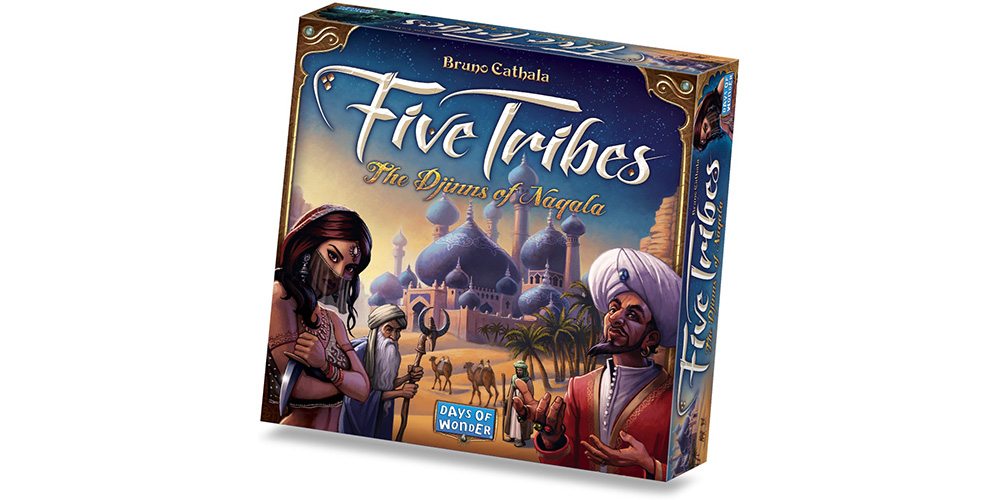

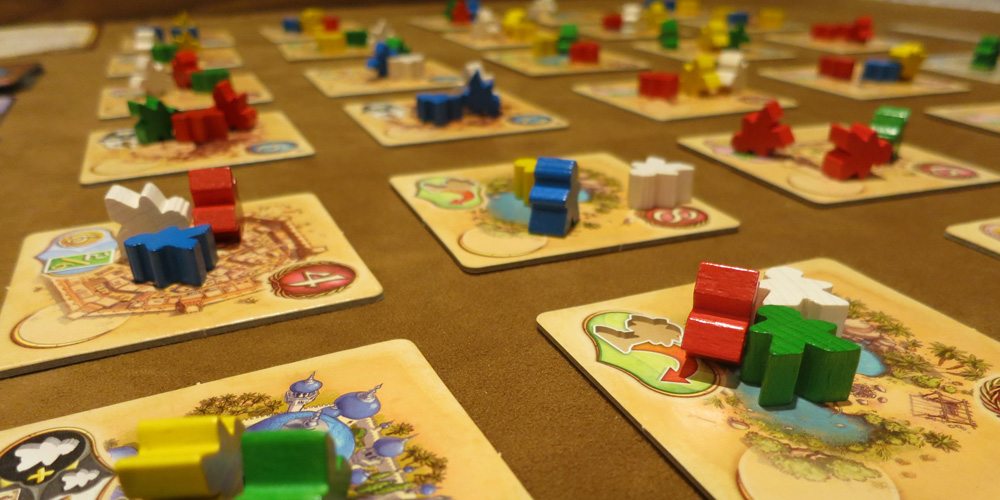


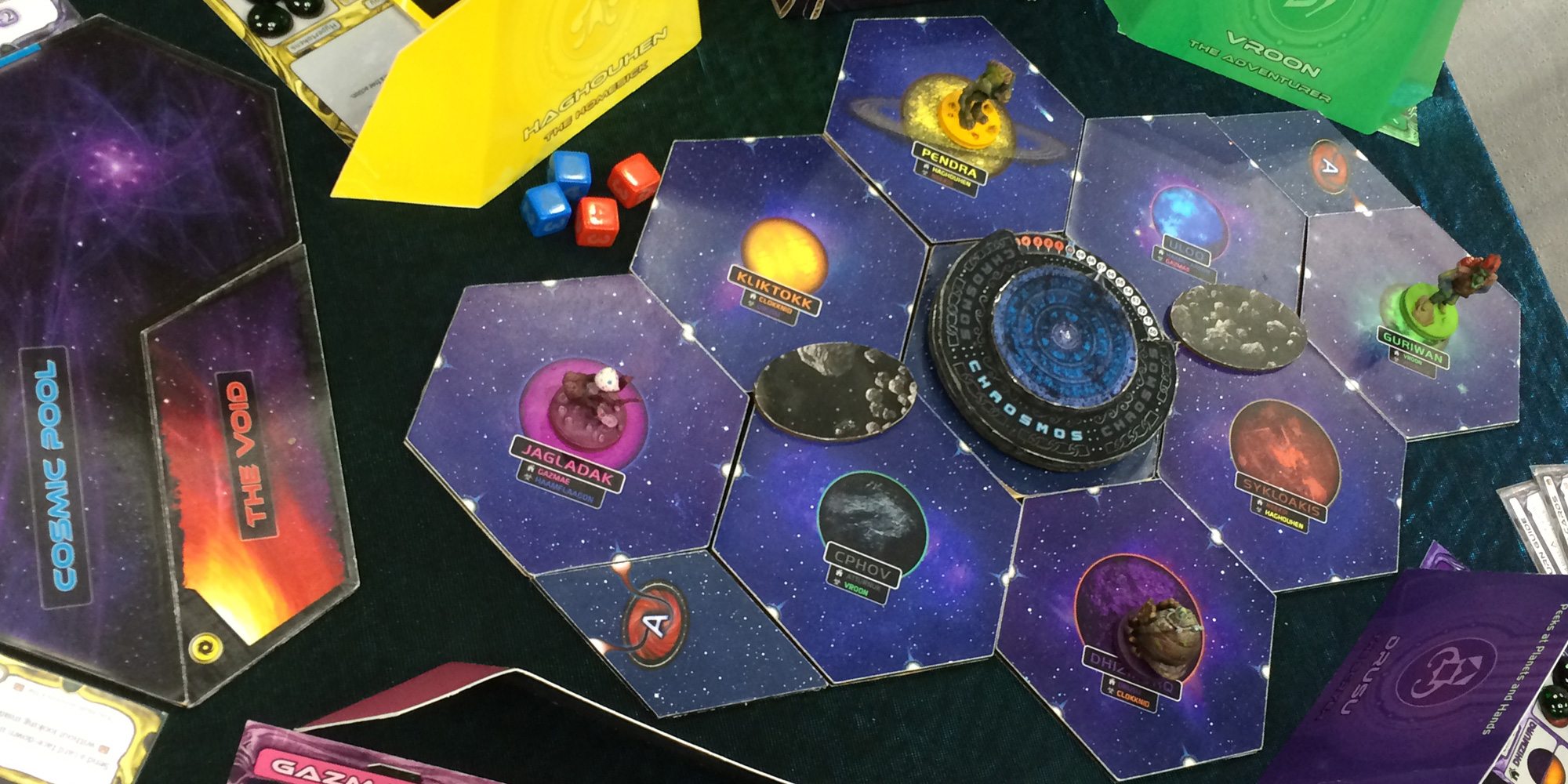


I got a chance to play this at Gencon. I can’t say enough good things about the mechanics and quality of the game, but it does have one glaring flaw: It encourages players to stop at every turn and count out the most “valuable” path for each turn they take. This happens at the bidding process then it happens every. subsequent. turn. This makes the game fairly cerebral, but it cuts down on any meaningful flow and exchange between players. If you have a player in your gaming group with analysis paralysis this game (while excellent) will take an hour longer than it needs to.
Yes there are multiple ways to win, but the easiest way to victory is through intelligent pathing and gathering of meeples. Since this is spread out across four or five different colors of meeples (and the various bonuses they offer) it has (in my experience with the game thus far) brought an otherwise enjoyable game to a grinding halt.
I agree with your statement that this is an excellent game– but I’ll just offer this word of warning to those of you with friends that suffer from analysis paralysis.